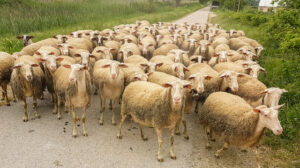Almost 8,000 sheep and goats have been killed in the last fortnight or are expected to be killed since the first case of plague was confirmed at a livestock unit in Kastraki, Kalambaka. This was the first time that the zoonosis was proven to have crossed the country’s borders.
Yesterday, according to official data, 3670 animals have been killed and another 4238 are expected to be killed. A total of 7,908 animals have already been lost in the first 18 cases detected in Trikala, Elassona, and the municipality of Tempe, where the last cases occurred.
Yesterday, the head of the Larissa prosecutor’s office ordered an urgent investigation to answer how, when, and by whom and from where the animals carrying the virus entered. However the veterinary authorities are following the same path as the zone control, samples are also taken from targeted controls in areas outside the surveillance. This practically means that already utilizing appropriate information the veterinary authorities know the course and where the sick animals that came from a third country ended up as is the most likely scenario so far. According to sources from the ministry want first to finish with the spread of the disease and then in a second year to make official announcements on how the plague entered the country.
However, the results of the samples in the next few days are crucial to confirm or not the optimism about the spread of the disease. Today, the Regional Head of Thessaly filed a lawsuit with the prosecutor’s office of Trikala after a publication concerning the burial of animals with plague that was not carried out according to the prescribed procedures.
It is noted that so far a total of 18 cases of goat and sheep plague have been recorded in Trikalaand Larissa since July 11 when the first case was recorded. Of these, 10 were detected in the Regional Unit of Trikala and 8 in the Regional Unit of Larissa. An outbreak means the whole flock.
Due to the cases, two zones have been defined:
-
- – the first is a protection zone and has a radius of 3 km
.
- – the second is a surveillance zone with a radius of 10 km.
According to information, of the 300,700 animals located in the two zones and the two district units, 182,400 have been checked as follows:
- – In the Region of Trikala in the protection zone there are 3,500 animals and all 3,500 have been checked and in the surveillance zone, 18,000 animals and 16,000 have been checked.
- – In the Larissa region, three protection zones and three surveillance zones have been designated. In the protection zones there are 80,700 animals and 70,600 animals have been checked.
As noted by competent sources, the number of animals and zones increases each time a new case is confirmed.
The same sources explain that animals are clinically tested and samples are taken for laboratory analysis from both symptomatic and asymptomatic animals. At the veterinary laboratories, 1,775 samples have been sent to the veterinary laboratories as of yesterday.
The inspections are carried out daily by 38 crews consisting of 90 veterinarians, who perform clinical examinations of the animals, and 10 crews of EFET consisting of 25 scientists, who inform and certify the compliance of the measures in the cheese dairies of the region.
At the level of dairies, out of a total of 90, 70 have been updated and tomorrow, Friday, it is estimated that the update will be completed.
In total, more than 140 people (scientists and support staff in the field and administrative support and veterinary laboratories) are employed in the management of sheep and goat disease with the operation continuing with unabated intensity until all animals are controlled and eradication of the disease is achieved.
Ask me anything
Explore related questions





